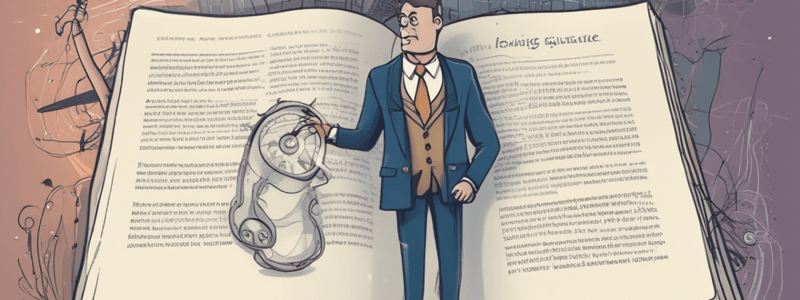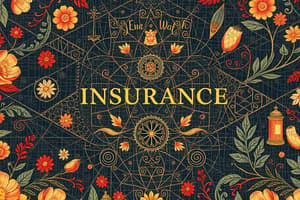Podcast
Questions and Answers
What type of insurance is specifically required by law for vehicle ownership?
What type of insurance is specifically required by law for vehicle ownership?
- 3rd party insurance (correct)
- Comprehensive insurance
- Household insurance
- 3rd party fire and theft insurance
How do business insurance premiums generally compare to household insurance premiums?
How do business insurance premiums generally compare to household insurance premiums?
- They are usually lower due to less risk.
- They are the same because both cover similar risks.
- They fluctuate more frequently than household premiums.
- They may be higher due to greater business risks. (correct)
Which of the following is NOT a similarity between business and household insurance?
Which of the following is NOT a similarity between business and household insurance?
- Both engage in risk management
- Both can treat premiums as tax-deductible (correct)
- Both fill out insurance forms
- Both identify risk
Which insurance type would a household NOT typically require?
Which insurance type would a household NOT typically require?
What is a key benefit of having business insurance?
What is a key benefit of having business insurance?
What does having insurance typically improve in a business context?
What does having insurance typically improve in a business context?
What is a common misconception regarding insurance savings?
What is a common misconception regarding insurance savings?
What is one reason why businesses might improve safety standards?
What is one reason why businesses might improve safety standards?
Which of the following describes a characteristic unique to business insurance?
Which of the following describes a characteristic unique to business insurance?
What aspect of insurance helps businesses manage unexpected financial burdens?
What aspect of insurance helps businesses manage unexpected financial burdens?
Flashcards are hidden until you start studying
Study Notes
Insurance Basics
- A policy is a contract between an insurer (insurance company) and the insured (individual or entity) for compensation of losses at a premium cost.
- Premium amounts are influenced by risk levels; higher risk correlates with higher premiums.
- Risk management involves strategies to minimize or eliminate potential risks for individuals and companies.
Key Terms
- Insurer: The insurance company providing coverage.
- Insured: The person or entity covered by an insurance policy.
- Policy: The contract specifying coverage terms.
- Premium: The fee for insurance coverage; higher risk leads to higher premiums.
- Loading: Additional charges on premiums due to increased risk factors, such as health risks associated with smoking.
- Actuary: A professional who assesses risk and calculates appropriate premium rates.
- Assessor: An independent investigator who examines claims and determines compensation amounts.
- Proposal Form: A document filled out by the insured providing necessary information for coverage assessment.
- Cover Note: Temporary proof of insurance until the full policy is issued.
- Renewal Notice: Reminder sent before policy expiration regarding premium due and renewal options.
- Days of Grace: Period allowing premium payment after renewal date without losing coverage.
- Exemption/Exclusion Clause: Specifies items or risks not covered by the policy.
Risk Management Process
- Identification: Recognizing potential risks such as fire or personal injury.
- Measuring: Estimating the likelihood of risks occurring.
- Protection Cost: Calculating expenses needed to protect against identified risks.
- Risk Reduction: Implementing strategies like insurance to minimize financial impacts of risks.
Risk Reduction Methods
- Insurance: Transferring risk to an insurer for compensation in case of loss.
- Safe Procedures: Establishing strict operational protocols to mitigate risks.
- Health and Safety: Training employees and providing protective equipment.
- Security Systems: Installing alarms, CCTV, and other safety measures.
Factors Influencing Insurance Premiums
- Risk level and historical claims data affect premium rates.
- Higher insured item values result in increased premiums.
- Additional loading for higher risk factors can be applied.
- No Claims Bonus rewards customers with discounts for claim-free periods.
- Insurers' profit targets and government levies can increase overall costs.
- Frequency of prior claims on a specific item will elevate premium rates.
Insurance Process Overview
- Initial contact with the insurance company.
- Completion of a proposal form with complete and truthful information.
- Assessment by the insurer to calculate risk and premium.
- Issuance of the insurance policy and acceptance by the insured.
- Provision of a cover note while waiting for the finalized policy.
Insurance vs. Assurance
- Insurance provides coverage against potential risks (e.g., fire).
- Assurance gives coverage for certain inevitable losses (e.g., life insurance).
Life Assurance Policy Types
- Whole Life Policies: Payout upon the insured's death.
- Endowment Policies: Payout either on reaching a certain age or upon death.
- Term Policies: Coverage for a specified period, with no payout if the insured survives the term.
Principles of Insurance
- Insurable Interest: The insured must have a financial stake in the item covered.
- Utmost Good Faith: Full disclosure of relevant information is required during the application process.
- Indemnity: Ensures no profit is made from claims; compensation equals the loss incurred.
Subrogation and Contribution
- Subrogation: Post-compensation rights for insurers to recover costs from responsible third parties.
- Contribution: This principle prevents multiple payouts from different insurers for the same loss by apportioning claims among insurers.
Business Insurance Types
- Public Liability Insurance: Covers claims from the public due to incidents on business premises.
- Employer’s Liability Insurance: Protects against employee claims for workplace injuries.
- Fidelity Guarantee Insurance: Safeguards businesses against employee theft or fraud.
- Theft Insurance: Coverage for stolen items or funds.
- Fire Insurance: Protection against fire-related damage to property.
- Consequential Loss Insurance: Covers loss of profits during business interruptions.
Similarities and Differences in Insurance
- Both business and household insurance involve risk identification, management, and adherence to insurance principles.
- Businesses typically require more diverse coverage compared to households, face greater risks, and can deduct premiums from taxes.
Importance of Insurance
- Business continuity through protection against catastrophic losses.
- Enhanced safety in transporting goods via insurance coverage.
- Insurance can save money in the long term by avoiding significant financial losses from unforeseen events.
- Contributes to better safety standards to lower premiums.
- Helps maintain cash flow by mitigating the financial impact of accidents or damages.
Studying That Suits You
Use AI to generate personalized quizzes and flashcards to suit your learning preferences.



